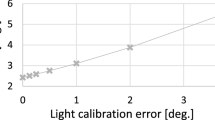Abstract
The problem associated with calibrating a structured light stripe system is that known world points on the calibration target do not normally fall onto every light stripe plane illuminated from the projector. We present in this paper a novel calibration method that employs the invariance of the cross ratio to overcome this problem. Using 4 known non-coplanar sets of 3 collinear world points and with no prior knowledge of the perspective projection matrix of the camera, we show that world points lying on each light stripe plane can be computed. Furthermore, by incorporating the homography between the light stripe and image planes, the 4 × 3 image-to-world transformation matrix for each stripe plane can also be recovered. The experiments conducted suggest that this novel calibration method is robust, economical, and is applicable to many dense shape reconstruction tasks.
Similar content being viewed by others
References
Alexander, B.F. and Ng, K.C. 1987. 3D Shape measurement by active triangulation using an array of coded light stripes. SPIE: Optics, Illumination and Image Sensing for Machine Vision II, 850:199–209.
Åström, K. and Morin, L. 1992. Random cross ratios. Rapport Technique RT88 IMAG-14, LIFIA, Institut Imag, Grenoble, France.
Bolles, R.C., Kremers, J.H., and Cain, R.A. 1981. A simple sensor to gather three-dimensional data. Tech. Report 249, SRI International, Stanford University.
Bottema, O. and Roth, B. 1979. Theoretical Kinematics. North-Holland: Amsterdam.
Chen, C.H. and Kak, A.C. 1987. Modeling and calibration of a structured light scanner for 3D robot vision. In Proc. IEEE Conf. Robotics and Automation, Vol. 2, pp. 807–815.
Faugeras, O. 1993. Three-Dimensional Computer Vision—A Geometric Viewpoint. The MIT Press: Cambridge.
Golub, G.H. and Van Loan, C.F. 1996. Matrix Computations. Johns Hopkins series in the mathematical sciences, 3rd edition, The Johns Hopkins University Press: Baltimore and London.
Huynh, D.Q. 1997. Calibration of a structured light system: A projective approach. In Proc. IEEE Conf. on Computer Vision and Pattern Recognition, Puerto Rico, pp. 225–230.
Jarvis, R.A. 1983. A perspective on range finding techniques for computer vision. IEEE Trans. on Pattern Analysis and Machine Intelligence, 5(2):122–139.
Jezouin, J.L., Saint-Marc, P., and Medioni, G. 1988. Building an accurate range finder with off the shelf components. In Proc. IEEE Conf. on Computer Vision and Pattern Recognition, pp. 195–200.
Lee, T. and Wong, S.B. 1992. An active triangular range finder and reflectance sensing using scanning mirror. In ICARCV'92, Vol. 1, pp. CV-5.6.1–CV-5.6.5.
Maybank, S.J. 1995. Probabilistic analysis of the application of the cross ratio to model based vision. International Journal of Computer Vision, 16(1):5–33.
Mood, A.M., Graybill, F.A., and Boes, D.C. 1974. Introduction to the Theory of Statistics. 3rd edition, McGraw-Hill.
Pavlidis, T. 1982. Algorithms for Graphics and Image Processing. Springer-Verlag: Berlin-Heidelberg.
Reid, I.D. 1996. Projective calibration of a laser-stripe range finder. Image and Vision Computing, 14(9):659–666.
Sato, Y., Kitagawa, H., and Fujita, H. 1982. Shape measurement of curved objects using multiple slit-ray projections. IEEE Trans. on Pattern Analysis and Machine Intelligence, 4(6):641–646.
Sato, K., Yamamoto, H., and Inokuchi, S. 1986. Tuned range finder for high precision 3D data. In Proc. International Conference on Pattern Recognition, Paris, France, pp. 1168–1171.
Semple, J.G. and Kneebone, G.T. 1952. Algebraic Projective Geometry. Oxford University Press.
Shirai, Y. and Suwa, M. 1971. Recognition of polyhedrons with a range finder. In 2nd Int. Joint Conf. on AI, London, pp. 80–87.
Author information
Authors and Affiliations
Rights and permissions
About this article
Cite this article
Huynh, D., Owens, R. & Hartmann, P. Calibrating a Structured Light Stripe System: A Novel Approach. International Journal of Computer Vision 33, 73–86 (1999). https://doi.org/10.1023/A:1008117315311
Issue Date:
DOI: https://doi.org/10.1023/A:1008117315311




